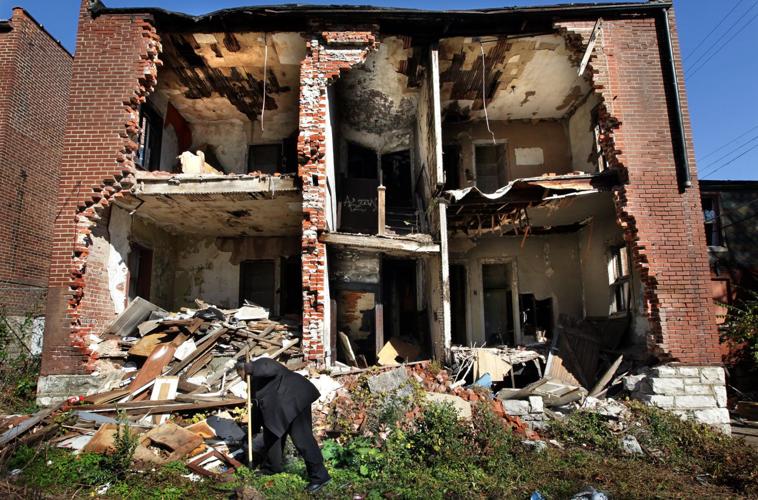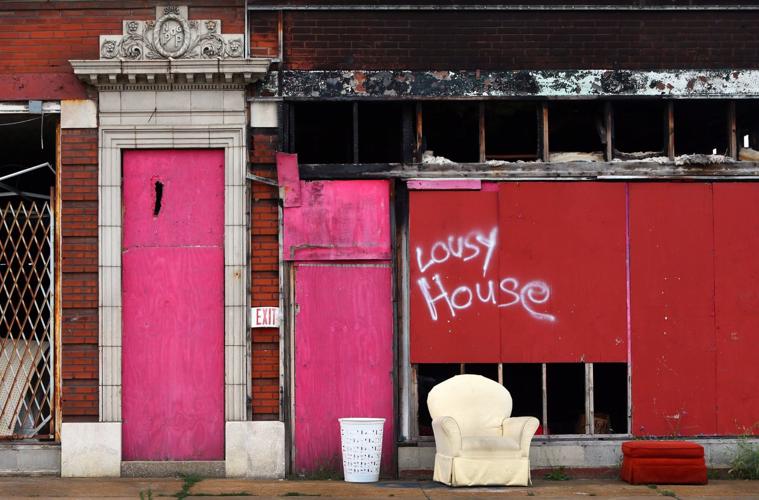ST. LOUIS ŌĆó It has been almost a quarter of a century since the 51║┌┴Ž NAACP first posted bright pink fliers along Delmar Boulevard with the headline ŌĆ£Missing.ŌĆØ
The pink leaflets and mailers that went out around 51║┌┴Ž in the fall of 1993 sought the department stores, groceries and restaurants that were conspicuously absent on the cityŌĆÖs North Side.
Today, whole blocks still sit empty, groceries are scarce and the cityŌĆÖs homicides remain concentrated in a handful of North Side neighborhoods. Thousands more people have left the area.
Home values stabilized after the 2008 housing crash in much of the city. But they continued to slide in nearly all neighborhoods north of Delmar even after the recession.
As big development projects move forward in the cityŌĆÖs central corridor, and many south 51║┌┴Ž neighborhoods notch at least modest increases in home values, north 51║┌┴Ž has mostly been left behind.
People are also reading…
ŌĆ£There are two different cities,ŌĆØ said the former director of the Greater Ville Preservation Commission, Harold Crumpton, who worked in the once proud, predominantly black neighborhood for years. ŌĆ£Economically speaking, weŌĆÖre still where we were in the 1940s.ŌĆØ
Post-Dispatch Analysis of data from city of 51║┌┴Ž Assessor. 2015 was the most recent city assessment. *Excludes tax-abated properties and neighborhoods with fewer than 50 single family homes. The Covenant Blu/Grand Center neighborhood, which straddles Delmar, is listed individually in the chart.
With Mayor Francis SlayŌĆÖs 16-year tenure ending, the candidates competing in the March 7 primary to pick finalists to replace him agree that north 51║┌┴Ž deserves a renewed focus from City Hall. Most also agree that
But with a budget that is stretched thin, figuring out a way to reverse the decline is a tall order.
A paper co-written by University of Missouri-51║┌┴Ž Professor Todd Swanstrom found that ŌĆ£not a single majority black neighborhood in 1970 that was surrounded by other black neighborhoods rebounded in the subsequent decades.ŌĆØ
Swanstrom said: ŌĆ£You canŌĆÖt wave your wand and revitalize the entire north side.ŌĆØ
Overcoming the demographic forces and migration patterns that have led to a decades-long trend of disinvestment and abandonment is probably beyond the power of the city alone. The new mayor will need to reach out to foundations, universities and other entities outside of government to find additional funding for social services and neighborhood building, Swanstrom said.
And the city will need to focus on just a few neighborhoods at a time, he said, concentrating resources to make real change rather than spreading them out over too much of the city.
ŌĆ£WeŌĆÖre going to have be very strategic and very concentrated and very smart,ŌĆØ Swanstrom said.
ŌĆśMarshall PlanŌĆÖ needed
Mayoral candidate Jeffrey Boyd agrees. As the cityŌĆÖs 22nd Ward alderman, Boyd said, heŌĆÖs had a firsthand look at how parts of the North Side have suffered while downtown and the central corridor have received attention from the mayorŌĆÖs office and developers.
ŌĆ£The buck always stops in the mayorŌĆÖs office, and as mayor, I will prioritize stopping the hemorrhaging that we are seeing in some of these crumbling neighborhoods,ŌĆØ he said.
Boyd said voters should look to the $34 million Arlington Grove housing and commercial complex he spearheaded on Burd Avenue off Martin Luther King Drive.
ŌĆ£ThatŌĆÖs a success story that I was able to get done, but itŌĆÖs small compared to the big picture,ŌĆØ Boyd said. ŌĆ£We need to identify the top three neighborhoods in our city that need help and then we go hard in those three neighborhoods.ŌĆØ
All the candidates vying to occupy the mayorŌĆÖs office appear to agree that more local resources should be brought to bear to begin rebuilding the largely poor, largely black neighborhoods north of Delmar Boulevard.
ŌĆ£Everybody wins from that,ŌĆØ Aldermanic President Lewis Reed said. ŌĆ£Not just the North Side ŌĆö the central corridor, the South Side.ŌĆØ
It will take more than boosting the police presence in order to bring down crime and encourage investment, said Alderman Antonio French, 21st Ward. French has long touted a plan targeting 15 high-crime city neighborhoods ŌĆö 12 of which are on the North Side ŌĆö with a myriad of programs: after-school activities for youth, neighborhood business plans and storefront job training and employment centers.
ŌĆ£Police canŌĆÖt do it themselves, nor are they the right tool to transform neighborhoods,ŌĆØ French said.
City Treasurer Tishaura Jones said City Hall needed to develop a citywide plan with community input.
ŌĆ£Because the people in those neighborhoods know where our bank and food and retail deserts are,ŌĆØ Jones said. ŌĆ£LetŌĆÖs plot it all out as if money is no object and figure out what we want to see. From there, we can identify what resources we have and then find money to do the things we want to do.ŌĆØ
Any plan developed under her administration would require a certain percentage of new developments to be set aside for affordable housing. It also would keep a keen eye toward not ŌĆ£gentrifyingŌĆØ communities, she said.
Former Alderman Jimmie Matthews said part of North 51║┌┴Ž ŌĆ£needs a Marshall Plan.ŌĆØ He wants to give 51║┌┴Ž residents and companies priority on city construction projects to help boost employment. But locals, he said, should decide what investment comes to their neighborhood.
ŌĆ£The people who live on that block and in that neighborhood should determine what happens in that neighborhood,ŌĆØ Matthews said.
Reed sounded a similar note, arguing that the city needed to increase efforts to involve residents in shaping development in their community. Implementing smaller land-use and development plans encompassing a handful or even just individual neighborhoods would help get residents involved and guide development in areas that need investment.
ŌĆ£What theyŌĆÖve tried to do in the past are these large-scale, vast plans that overlay acres and acres,ŌĆØ he said.
City land for sale
Other candidates called for selling more of the 12,000 properties owned by the cityŌĆÖs Land Reutilization Authority, many of which are on the North Side. French wants the city to ŌĆ£aggressively marketŌĆØ LRA property and pair them with tax incentives.
Source: Post-Dispatch analysis of data from the City of 51║┌┴Ž Assessor
ŌĆ£We need to use our tax incentives in areas that state law intended them to be used on, which are actually blighted areas,ŌĆØ French said.
Boyd wants to fully fund the cityŌĆÖs pool of money set aside to demolish vacant properties.
ŌĆ£We need to put that $3 million back into the demolition fund, because right now a lot of that money is being used for other things.ŌĆØ
Alderman Lyda Krewson, 28th Ward, favors offering LRA properties to small developers at ŌĆ£extremely low pricesŌĆØ and packaged with city-funded amenities ŌĆö such as a new sidewalk or a small tax abatement ŌĆö to make the deal more attractive.
Any deals should come with clearly defined restrictions, Krewson said. As mayor, she would push for a two-year window for those developers to rehab the property. Failing that, those properties would revert to city ownership.
ŌĆ£You donŌĆÖt want to sell properties for little or no money and then end up two years later and the building is still deteriorated,ŌĆØ she said.
A recent report found the LRA is understaffed compared with other landbanks in the country and receives no general revenue from the cityŌĆÖs budget, forcing it to rely entirely on fees from real estate sales.
ŌĆ£What theyŌĆÖre talking about needs manpower,ŌĆØ said 51║┌┴Ž Development Corp. chief Otis Williams, who oversees the LRA.
Most of the candidates interviewed agreed that the new National Geospatial-Intelligence Agency headquarters scheduled to open a new campus in the 51║┌┴Ž Place neighborhood by 2020 was an opportunity to spark an economic revival.
ŌĆ£But weŌĆÖve got to do it right,ŌĆØ Krewson said. ŌĆ£We need to make it so people want to live around it.ŌĆØ
Around the NGA, and in all projects, Jones said, city leaders need to become more open to creative solutions.
ŌĆ£We suffer from not looking outside of our borders to see how other cities have come back,ŌĆØ Jones said. ŌĆ£WeŌĆÖre just using the same tools over and over again.ŌĆØ
Paying for it
Financing programs to improve the quality of life in neighborhoods on the edge, French argues, is a matter of reallocating resources and putting the brakes on committing money to ŌĆ£wants instead of needsŌĆØ ŌĆö a dig at the Board of AldermenŌĆÖs recent vote to finance $64 million in improvements to the Scottrade Center.
ŌĆ£The programs that weŌĆÖre talking about are not expensive,ŌĆØ French said.
Elected School Board member Bill Haas said he was open to giving tax breaks to developers, provided they had a concrete plan to redevelop specific neighborhoods.
ŌĆ£The city has had its priorities backward,ŌĆØ Haas said. ŌĆ£TheyŌĆÖve been giving away all this money, focusing on downtown, when they could have been using that on schools and police. If you build strong neighborhoods, a strong downtown will follow.ŌĆØ
Krewson said funding neighborhood revitalization would probably come from a mix of block grants and tax incentives for small developers. The next mayor will also have to dedicate city funds to take care of quality of life initiatives including alley cleanup and street lighting.
ŌĆ£Development generally doesnŌĆÖt affect [the cityŌĆÖs] general revenue,ŌĆØ she said. ŌĆ£What we need is more planning.ŌĆØ
Reed said investing in youth programs and other services to reduce the unemployment rate can grow general revenue to fund additional police and other services.
ŌĆ£We canŌĆÖt arrest our way out,ŌĆØ he said. ŌĆ£We have to invest our way out.ŌĆØ
Republicans respond
Utility executive Andrew Jones also said resources should be reallocated based on violent crime.
ŌĆ£We are going to focus on the small segment in north 51║┌┴Ž, and some pockets in south 51║┌┴Ž, who are involved in violent crime,ŌĆØ Jones said. ŌĆ£Our police know who they are.ŌĆØ
After crime is reduced, he said, ŌĆ£we will put in the best practices of economic development.ŌĆØ
Businessman Jim Osher said he wanted the focus to be on reducing blight and dilapidated structures. Osher, who owned the old Buster Brown Shoe Factory at Cass and Jefferson avenues before the city acquired it to assemble a site for the NGA, said he was familiar with the area and said cleaning up the neighborhoods would help market it.
The city should invest a chunk of cash, perhaps several million, to step up its demolition and maintenance programs, Osher said. That may well require raising revenue.
ŌĆ£To me it seems like we should just clean up the area first,ŌĆØ he said. ŌĆ£DonŌĆÖt you think people would be willing to pay a little more?ŌĆØ
Walker Moskop of the Post-Dispatch contributed to this report.
51║┌┴Ž mayoral candidates on North 51║┌┴Ž revitalization
DEMOCRATS
Jeffrey Boyd
- Identify three neighborhoods and focus resources to revitalize them
- Add more money to the cityŌĆÖs vacant property demolition fund
Antonio French
- Focus programs and policing on 15 high-crime neighborhoods.
- Establish neighborhood police liaisons
Bill Haas
- Reduce development incentives to grow revenue for police and schools
- Offer incentives for development in certain areas
Tishaura Jones
- Develop a city-wide development plan to identify high-priority neighborhoods and their needs
- Craft development agreements requiring set-asides for affordable housing and small business
Lyda Krewson
- Sell property owned by city land bank at cut-rate prices and pair it with incentives
- Dedicate more city funds for quality of life issues like street lights and alley cleanup
Jimmie Matthews
- Give city residents priority on construction contracts
- Let neighborhood residents shape development proposals
Lewis Reed
- Implement neighborhood-scale growth and development plans
- Target individuals prone to violent crime with every legal remedy available
REPUBLICANS
Andrew Jones
- Refocus and concentrate police resources in violent areas
- Form a task force focused on violent crime reduction strategies
Jim Osher
- Reduce blight and vacant buildings
- Clean up alleys and trash to make the area more marketable
Note: A third Republican, Andy Karandzieff, is also on the March 7 GOP ballot, but he has said he is running to attract publicity for his business.
















